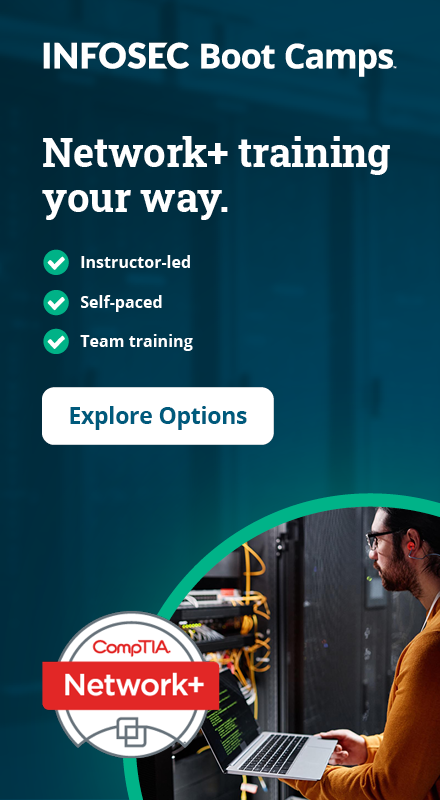CompTIA Network+ interview questions [2025 update]
The recently refreshed 2025 CompTIA Network+ exam is the first step into exciting IT and cybersecurity roles like systems administrators, IT managers, network security analysts, network engineers, data architects, solutions architects and cybersecurity analysts.
With a 2025 average annual salary of $81,643 for Network+ certification holders, this in-demand certification will most likely lead to job interviews with potential employers assessing basic technical skills. Download the free cybersecurity certification ebook for entry-level security professionals to explore other options beyond Network+.
In this guide, we’ll review potential questions and answers revolving around Network+ certification topics that might be asked during a job interview. As the new N10-009 network+ exam covers troubleshooting, configuring and managing networks, expect questions around fundamentals, common protocols, configurations, cyberattacks, troubleshooting and performance optimization.

Earn your Network+ certification, guaranteed!
Define a network
A network is a group of computers, routers, cables and other hardware that allows users to share files, email and connect to the internet. This might be a basic starting question.
What is a node?
A node is anything that acts as a connection, including endpoints or distribution points over a network that can receive, create, store and send data along distributed routes.
What does a router do?
A router directs traffic across a network, allowing multiple networks to communicate by directing data packets to different IP addresses.
What protocol can you use to automatically assign IP addresses?
To automatically assign IP addresses to desktops, servers or printers, use the Dynamic Host Configuration Protocol (DHCP). Servers and printers will have a static IP address.
What is a protocol?
A protocol is a set of established rules that define how information is exchanged. It governs how data is sent and received between devices on a network.
If your users cannot access a server, what can you do to test server connectivity?
Use “ping” commands to see if packets are returned, meaning the server is turned on and connected. You can either remote into the computer using Remote Desktop Protocol or Secure Shell to check for performance or use custom tools like SolarWinds to check for server resources.
What is the physical layer in the OSI model?
It’s the bottom-most layer in the Open System Model (OSI) that handles the actual transmission of data over electrical, mechanical or procedural interfaces. It’s the ones and zeros that transport information across cables.
What is the network layer of the OSI model?
As the third layer of the OSI model, it’s responsible for data routing, forwarding and addressing.
What is the process used to protect the company from losing massive data?
Disaster recovery (DR) is the process of creating backups and storing data safely and securely away from cybercriminals, natural disasters, systems failures or other incidents. Disaster recovery then brings systems back online, restoring function and access.
What is a subnet?
A subnet is a segmented part of the network separated by a router. It essentially creates smaller, more manageable networks to increase efficiency and improve traffic management. It’s also called “a network within a network.”
In subnetting, mask /24 has how many addresses and hosts? How is the netmask represented?
/24 has 256 addresses and 254 hosts, and the netmask is 255.255.255.0.
Name some open-source network analysis/scanning tools that could be used to discover weaknesses.
Potential options could include Nmap, Metasploit, Nessus, WireShark and Angry IP scanner. These questions are meant to assess your knowledge of developing a practical tech stack.
Describe the TCP three-way handshake process.
The TCP three-way handshake process initiates a connection in a transmission control protocol/internet protocol (TCP/IP) network. The goal is to establish a secure connection and reliable communication before data transmission begins.
It involves three steps: synchronize (SYN), synchronize-acknowledge (SYN-ACK) and acknowledge (ACK). The initiating computer sends a SYN packet to a server to ask if open connections are available. Then, the receiving computer sends back a packet. The initiating computer then sends an acknowledge sequence number (ACK) back.
What is seen in a typical CISCO router configuration?
A typical CISCO writer configuration includes interface information, static routes, VPN connections, ACLs, IOS, time zones, users and password hashes.
Name a protocol analyzer.
WireShark, SolarWinds, Network Miner or Omnipeek. For these types of questions, have real-world practical application stories to share that focus on the implementation, usage and maintenance of these systems.
Name some routing protocols.
Routine tools direct data packets, essentially choosing the best path for information to travel. Examples include order gateway protocol (BGP), external gateway protocol (EGP), routing information protocol (RIP), open shortest path first (OSPF) and enhanced internet gateway routing protocol (EIGRP).
When answering, explain how and why you might choose one routing protocol over the other, such as network size, complexity, administrative distance, etc.
What is the difference between TCP and UDP?
TCP (Transmission Control Protocol) is connection-oriented for reliability, and UDP (User Datagram Protocol (UDP) does not establish this connection when sending data, meaning some data might get lost in transmission. The main difference revolves around speed and reliability, with TCP being slower but more reliable, while UDP is fast but might incompletely deliver data.
Name some mail protocols and their port numbers.
SMTP (25), Pop (110) and IMAP (143). Again, for questions like these, have case study examples prepared to describe your experience setting up mail protocols.
How do you determine the type of web server used on a certain site?
Perform a banner grab to analyze the server response headers. There are different free online tools you can use, or you can inspect the source code.
What is port 53?
Port 53 is the designated port for DNS protocol, which helps improve its reliability and faster resolution of domain names into IP addresses by distributing queries across multiple servers.
What happens in the backend when you type www.google.com or any URL into the browser bar?
The address goes to the DNS server to resolve the domain name to the IP address. The interviewer may then ask, “Which DNS server?” This answer is specific to your network configuration, which then contacts the authoritative name server for the IP address.
If you ping a site, like www.google.com, and the TTL says 123, what does that tell you?
TTL stands for “Time to Live,” and it is a value in an IP packet that tells the network whether to discard the package. Each router that a packet passes through decreases the TTL by at least one, and Windows uses a TTL of 128 by default. A TTL of 123 suggests the target host was five hops away.
What command would you use to get the local routing table listing?
You would use Netstat-r.
How many layers are in the OSI model, and what are they?
The OSI model includes seven layers: physical, data link, network, transport, session, presentation and application. These layers work together to communicate over a network compared to the TCP/IP model.
What are the benefits of SD-WANs?
Software-Defined Wide Area Networks (SD-WANs) help automate network and security deployment, configuration and change management. Benefits include cost savings, improved network reliability, operational simplicity and improved security.
What are common features of Next-Generation Firewalls?
Next-generation firewalls monitor for malicious activity based on specific behavior or anomalies. Characteristics include deep packet inspection, intrusion prevention systems, URL filtering, SSL inspections, sandboxing, remote access VPNs and threat intelligence.
In client-to-site VPNs, what are full tunnels and split tunnels mode?
You can either send traffic through a VPN (full tunneling) or split it between the VPN and the regular open network (split tunneling). This depends on your network capacity, security needs, bandwidth and speed. Full tunneling means higher security but split tunneling offers more flexibility while saving bandwidth.
What type of attack is switch spoofing, and what action can you take to mitigate it?
Switch spoofing is a VLAN-hopping attack that exploits misconfigurations. Mitigation strategies include implementing spoofing detection software and enabling cryptographic network protocols like TLS, SSH or HTTPS.

Earn your Network+ certification, guaranteed!
Preparing for Network+ interview questions
It’s exciting to have an interview after becoming Network+ certified, and it’s time to put your studying to the real test. Make sure you’re confident on the different domains within the Network+ exam, and connect abstract theory to practical, real-world experience.
Craft several basic examples using the STAR method describing a situation, task, action and result to highlight your experience. Review your old training materials like the Network+ Boot Camp or study guides or explore the free resources in the Network+ training hub.
For more interview tips, download our ebook, Cybersecurity interview tips: How to stand out, get hired and advance your career
Also, if you’re considering applying for different roles, download the free entry-level cybersecurity careers ebook to learn more about various career paths.






